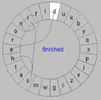



Data quality is critical for many information-intensive applications. One of the best opportunities to improve data quality is during entry. Usher provides a theoretical, data-driven foundation for improving data quality during entry. Based on prior data, Usher learns a probabilistic model of the dependencies between form questions and values. Using this information, Usher maximizes information gain. By asking the most unpredictable questions first, Usher is better able to predict answers for the remaining questions. In this paper, we use Usher's predictive ability to design a number of intelligent user interface adaptations that improve data entry accuracy and efficiency. Based on an underlying cognitive model of data entry, we apply these modifications before, during and after committing an answer. We evaluated these mechanisms with professional data entry clerks working with real patient data from six clinics in rural Uganda. The results show that our adaptations have the potential to reduce error (by up to 78%), with limited effect on entry time (varying between -14% and +6%). We believe this approach has wide applicability for improving the quality and availability of data, which is increasingly important for decision-making and resource allocation.


TapSongs are presented, which enable user authentication on a single "binary" sensor (e.g., button) by matching the rhythm of tap down/up events to a jingle timing model created by the user. We describe our matching algorithm, which employs absolute match criteria and learns from successful logins. We also present a study of 10 subjects showing that after they created their own TapSong models from 12 examples (< 2 minutes), their subsequent login attempts were 83.2% successful. Furthermore, aural and visual eavesdropping of the experimenter's logins resulted in only 10.7% successful imposter logins by subjects. Even when subjects heard the target jingles played by a synthesized piano, they were only 19.4% successful logging in as imposters. These results are attributable to subtle but reliable individual differences in people's tapping, which are supported by prior findings in music psychology.







